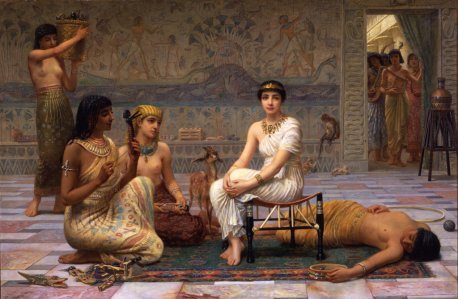Love's Labour Lost
Overview
Love's Labour Lost [ edit ]
One of the most successful painters of the Victorian period, Edwin Longsden Long (1829-1891) earned accolades as well as wealth during his long career and member of the Royal Academy. Among his most famous and enduring work are those that bring antiquity to life, such as his large 1875 canvas The Babylonian Marriage Market, a topic Long took from Herodotus’ Histories. Long achieved critical acclaim for his attention to historical detail, and the sale of the painting held a record for highest auction price that would not be broken until after Long’s death. In Love’s Labour Lost, Edwin Long has captured ancient Egyptian life in an equally dramatic, yet intimate, fashion in this highly detailed and thoroughly researched painting, one of several Egyptianizing canvases from his career (See Humbert, in Egyptomania, pp. 491-493; Bills, Edwin Longsden Long RA, pp. 112-113, 116-117, 169). The objects in the foreground and background, as well as the decoration of the rear wall and details of the clothing all find parallels in authentic ancient Egyptian artifacts. The stool on which the central figure sits is a faithful copy of an extant Eighteenth Dynasty stool in the British Museum, constructed of ebony with intricate ivory inlay (BM EA 2472); the collection of children’s toys in the left foreground and the objects strewn across the bench behind the group of women all find parallels in ancient Egyptian artifacts published in John Gardiner Wilkinson’s Manners and Customs of the Ancient Egyptians. The colorful “paddle doll,” although resembling a modern toy, was included in burials as representatives of the goddess Hathor and her role in the rebirth of the deceased. The segmented figure bent at work over a grinding stone is an unusually well-preserved toy that retains its functionality to this day in Leiden collection. Other artifacts in the painting include: two senet-boards, a cosmetic vessel in the shape of a duck, small faience vessels, an ivory chest, and a ceramic storage jar with wooden stand.
To create an authentic interior space, the rear wall of the chamber into which the viewer looks is decorated with a facsimile of an Egyptian tomb scene of the tomb owner fishing and fowling in the marshes, and Long has copied the details directly from Wilkinson’s Manners and Customs. Long has also brought several two-dimensional Egyptian images to life: the cat playing with the monkey to the left of the doorway appears in tomb scenes as well as figured ostraca. Musicians carrying accurate reproductions of ancient Egyptian lyres stride through a doorway decorated with uraei whose undulating tails fill the jambs. The musicians, like the toys in the lower foreground of the painting, are referenced in the poem that was juxtaposed with Love’s Labour Lost when it was first exhibited (quoted in Bills, Edwin Longsden Long RA, p. 145):
When like an opening bud the flower of Youth
Unfolds its petals to the light of Truth,
Then mimic toys and tales of wondorous lore,
By puppets acted, charm not as before.
Amusement wearies out her skill in vain,
And calls the aid of music’s magic strain;
But happy childhood’s limit passed for e’er
Youth rashly craves reality and care.
Unlike earlier Egyptianizing paintings that mix architecture, relief decoration, and objects from different periods of Egyptian history, Long has consistently chosen templates from the New Kingdom, particularly the Eighteenth Dynasty. This painting blurs the border between Egyptomania and Egyptology, and a delight in Egyptian motifs has become an equal delight in accurate scholarly representations thereof. In Love’s Labour Lost, Long creates a balanced and harmonious composition whose authentic details transform a pleasing genre scene into a journey back in time.
Date
1885
Dimensions
50 x 75 1/4 in
Artist or Author
Edwin Long
Provenance
England
Museum
Dahesh Museum
Accession Number
1995.1026
Gerald M. Ackerman, Les orientalistes de l’école britannique (Paris: ACR Édition 1991), p. 206.
Mark Bills, Edwin Longsden Long RA (London: Cygnus Arts, 1998), pp. 145-146 (no. 206).
D. Farmer and L. Small, A Distant Muse, Orientalist Works from the Dahesh Museum of Art (New York, 2000), pp. 18-20.
For the inlaid stool in the painting, based on BM EA 2472, see N. Strudwick, Masterpieces of Ancient Egypt (London, 2006), pp. 196-7; in fact, this type of Egyptian chair inspired William Holman Hunt to design his own “Thebes chair,” a beautiful example of Egyptomania in furniture design—see P. Conner, The Inspiration of Egypt: its influence on British artists, travelers, and designers, 1700-1900 (Brighton, 1982), pp. 100-101.












